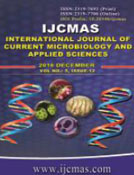


 National Academy of Agricultural Sciences (NAAS)
National Academy of Agricultural Sciences (NAAS)

|
PRINT ISSN : 2319-7692
Online ISSN : 2319-7706 Issues : 12 per year Publisher : Excellent Publishers Email : editorijcmas@gmail.com / submit@ijcmas.com Editor-in-chief: Dr.M.Prakash Index Copernicus ICV 2018: 95.39 NAAS RATING 2020: 5.38 |
As the first step in this direction; biosynthesis and characterization of zinc oxide nanoparticles (ZnO-NPs) and their use to ameliorate the toxic effects of aflatoxicosis in rabbit in comparison with curcumin were studied. Thirty-five healthy New Zealand rabbits were divided into 5 groups, each including 7 rabbits. Group 1 was kept as negative control without any treatment. Rabbits in the groups 2, 3, 4 and 5 were given AFB1 orally at a dose of 50 ug dissolved in 0.5 ml of olive oil/ animal daily, for 4 weeks. On day one following the administration of AFB1, curcumin was orally administered at a dose of 15 mg/kg b.w. for group 3. While, animals of Group 4, were orally administered AFB1 + ZnO-NPs (25 ug / kg of B.W. of animal /0.2 mL of buffer/day)( low dose). Animals of Group 5, were orally administered aflatoxins + ZnO- NPs (50 ug / kg of B.W. of animal /0.2 mL of buffer/day) ( high dose). The biochemical evaluation of rabbit sera after experimental study showed that AFB1 increased the concentration of NO and MDA, while decreased the level of GSH and activities of SOD, CAT and GSH-PX. Significant decreased values in plasma total protein, albumin, alpha globulin, beta globulin, and gamma globulin. Decrease in serum globulin in toxin fed group might be due to the adverse effect of aflatoxin B1 on synthesis of total proteins and globulin. The AFB1 had a drastic effect on liver and kidneys with marked genotoxic effect and inhibition of DNA, RNA and protein synthesis. These changes were improved by administration of ZnO-NPs or curcumin to aflatoxicated animal through the immune strengthening effect and protection of lipid and protein from oxidative damage. It is concluded that the addition of ZnO-NPs and curcumin to animal feed possesses hepato-protective effect through scavenging of free radicals, or by enhancing the activity of antioxidant, which then detoxify the free radicals. These factors protect hepatic cells from the damaging effect by AFB1 that could be progress to hepatocarcinmoa.
 |
 |
 |
 |
 |